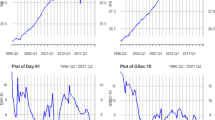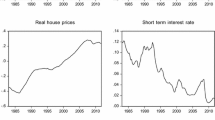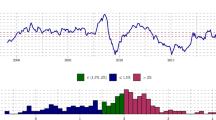Abstract
This paper, first, estimates the appropriate, log–log or semi-log, linear long-run money-demand relationship capturing the behavior US money demand over the period of 1980:Q1–2010:Q4, using the standard linear cointegration procedures found in the literature, and the corresponding nonparametric version of the same based on projection pursuit regression (PPR) methods. We then, compare the resulting welfare costs of inflation obtained from the linear and nonlinear money-demand cointegrating equations. We make the following observations: (i) the appropriate money-demand relationship for the period of 1980:Q1–2010:Q4 is captured by a semi-log function; (ii) based on the estimation of semi-log cointegrating equations, the welfare cost of inflation was found to at the most lie between 0.0131 % of GDP and 0.2186 % of GDP for inflation rates between 0 and 10 %, and; (iii) in comparison, the welfare cost of inflation obtained from the semi-log non-linear long-run money-demand function, derived using the PPR method, for 0–10 % of inflation ranges between 0.4930 and 1.9468 % of GDP. However, the standard errors associated with the welfare cost estimates obtained from PPR relative to the linear models tend to indicate that the nonlinear money demand provides more precise estimates of the welfare costs primarily for higher rates of inflation.



Similar content being viewed by others
Notes
Please refer to Sect. 3 of the current paper for further details.
Please refer to Sect. 4 of the current paper for further details.
Basics of the PPR method have been provided in the Sect. 3 and additional details appear in the Appendix of the paper.
To ensure consistency, all the computations, barring the PPR method, have been done using the codes written by Prof. Peter N. Ireland for his paper: On the Welfare Cost of Inflation and the Recent Behavior of Money Demand, which appeared in the June 2009 issue of the American Economic Review. The codes are available for download on his website: https://www2.bc.edu/peter-ireland/programs.html. For the PPR method, we relied on the “ppr” package in R.
Refer to Stock and Watson (1993) for further details.
Results from the super smoother and GCV splines methods are available upon request from the authors.
The values for the AIC were: \(-\)4.1539, \(-\)4.1491, \(-\)4.3334, and \(-\)4.4009 for \(p = 1, 2, 3\), and 4, respectively. Furthermore, analysis of variance (ANOVA) also ensured that the SSE for \(p = 4\) was significantly smaller compared to the cases of \(p = 1, 2\), and 3. Details of ANOVA analysis are available upon request from the authors.
The semi-elasticity: \(SE = \left. {\frac{{\mathrm{d}}\ln (m(r))}{{\mathrm{d}}r}} \right| _{r=r_0 } =\lim _{\varepsilon ->0^{+}} \frac{\ln (m(r_0 +\varepsilon )-\ln (m(r_0 )))}{\varepsilon }\) is estimated using a finite difference, that is,\(\frac{\ln (m(r_0 +\varepsilon _0 )-\ln (m(r_0 )))}{\varepsilon _0 }\left( {\mathrm{or}} \frac{\ln (m(r_0 +\varepsilon _0 )+\ln (m(r_0 )))}{\varepsilon _0 }\right) \), whichever appropriate) with \(=10^{-5}\), which is small enough to ensure that the finite difference is close to the derivative. Note, \(r_{0}\) denotes the point where the derivative is to be computed...
The full set of estimated parameters of the model, which includes the projection direction vectors and ridge coefficients have been suppressed here to save space. They are, however, available upon request from the authors, as are the results of the PPR model with \(p =\) 1, 2, and 3. For these three cases, the SE was not found to be significant with wide confidence bands. However, the estimated welfare costs, as reported below in Table 7, were virtually the same.
As with results reported in Table 4, the SSE was the lowest with \(p= 4\) for the bootstrapped DOLS, and again, as before the AIC was the lowest for this case, and the ANOVA indicated that the SSE for \(p= 4\) was significantly lower than with \(p = 1, 2\), and 3. Details of ANOVA analysis are available upon request from the authors. In addition, the full-set of results for \(p = 1, 2\), and 3 are also available upon request from the authors. As in Table 4, the results for the bootstrapped DOLS for values of \(p\) ranging between one and four were very similar, and, understandably, so were the welfare cost estimates.
The PPR method was found to produce lower SSEs in comparison to the bootstrapped DOLS for the cases of \(p = 1, 2\) and 3 as well.
We used a seed equal to 20 to obtain our results for the welfare costs. However, when we checked the robustness of our results based on seeds equal to 30 and 40, the welfare costs only changed at the sixth decimal place. The details of these results are available upon request from the authors. The small standard errors reported in Table 7, and also those obtained under the alternative seeds, also vouch for the robustness of our results.
If we replace the estimated intercept and the interest semi-elasticity obtained from the PPR in Eq. (5), the welfare costs of inflation for 0, 2, and 10 % of inflation are respectively, 0.0232, 0.0616, and 0.3444 % of GDP, which, in turn, are relatively higher compared to those obtained under the linear cases.
One of the referees suggested that we reevaluate our welfare cost estimates using the trapezoidal method for the numerical integration. Given that, the trapezoid method and Simpson’s method are comparable, but the fact that in most cases Simpson’s method is faster in terms of convergence (Atkinson 1989), we used the composite Simpson’s method of numerical integration instead. In this case, the number of points used for integration within each interval was \(n=10,000\). For this case, the welfare cost of inflation (standard errors) obtained from the semi-log nonlinear long-run money demand for 0, 2, and 10 % of inflation were found to be 0.52 (0.01), 0.88 (0.02), and 2.35 (0.05) % of GDP respectively, i.e., they were even higher compared to those obtained under the Monte Carlo integration, but also has higher standard errors.
For Lucas’ (2000) preferred log–log case 0 and 2 % rates of inflation produced welfare losses of 0.85 and 1.09 % of GDP, which are bigger relative to what our PPR method yields. However, at the 10 % level Lucas (2000) obtains a welfare cost of 1.76 % of GDP—a values less than what we obtain at the same level of inflation.
References
Atkinson KE (1989) An introduction to numerical analysis, 2nd edn. Wiley, New York
Bailey MJ (1956) The welfare cost of inflationary finance. J Polit Econ 64(2):93–110
Cagan P (1956) The Monetary dynamics of hyperinflation. In: Friedman M (ed) Studies in the quantity theory of money. University of Chicago Press, Chicago, pp 25–117
Cynamon BZ, Donald HD, Barry EJ (2006) Redefining the monetary aggregates: a clean sweep. East Econ J 32(4):661–672
Dotsey M, Peter NI (1996) The welfare cost of inflation in general equilibrium. J Monet Econ 37(1):29–47
Efron B, Tibshirani R (1993) An introduction to the bootstrap. Chapman and Hall, New York
Fischer S (1981) Towards an understanding of the costs of inflation: II. Carnegie-Rochester Conf Ser Public Policy 15:5–41
Friedman M (1969) The optimum quantity of money. In: Friedman M (ed) The optimum quantity of money and other essays. Aldine Publishing Company, Chicago, pp 1–50
Friedman JH, Werner S (1981) Projection pursuit regression. J Am Stat Assoc 76(376):817–823
Hamilton JD (1994) Time series analysis. Princeton University Press, Princeton
Ireland PN (2009) On the welfare cost of inflation and the recent behavior of money demand. Am Econ Rev 99(3):1040–1052
Johansen S (1991) Estimation and hypothesis testing of cointegration vectors in Gaussian vector autoregressive models. Econometrica 59:1551–1580
Lucas RE Jr (1981) Discussion of Stanley Fischer, towards an understanding of the costs of inflation: II. Carnegie-Rochester Conf Ser Public Policy 15:43–52
Lucas RE Jr (2000) Inflation and welfare. Econometrica 68(2):247–74
Meltzer AH (1963) The demand for money: the evidence from the time series. J Polit Econ 71(3):219–246
Newey WK, West KD (1987) A simple, positive semi-definite, heteroskedasticity and autocorrelation consistent covariance matrix. Econometrica 55(3):703–708
Phillips PCB, Ouliaris S (1990) Asymptotic properties of residual based tests for cointegration. Econometrica 58(1):165–93
Phillips PCB, Perron P (1998) Testing for a unit root in time series regression. Biometrika 75(2):335–46
Stock JH, Watson MW (1993) A simple estimator of cointegrating vectors in higher order integrated systems. Econometrica 61(4):783–820
Vinod HD (1998) Nonparametric estimation of non-Linear money demand cointegration equation by projection pursuit methods. In: Weisberg S (ed) Computing science and statistics. Interface Foundation, Fairfax Station, pp 174–183
Acknowledgments
We would like to thank two anonymous referees for many helpful comments that markedly improved the quality of the paper. However, any remaining errors are solely ours.
Author information
Authors and Affiliations
Corresponding author
Appendices
Appendix
See Table 8
The basics of projection pursuit method
PPR is an extension of additive models, and was developed by Friedman and Werner (1981). Like additive models, this model is helpful in reducing the curse of dimensionality in that it uses univariate regression functions, and not multivariate regression functions. Thus the estimation becomes much faster in terms of computation. But this model is different from additive models in that it first projects the data matrix of explanatory variables (usually denoted by \(X)\) in the optimal direction before applying smoothing functions to these explanatory variables.
The model consists of linear combinations of non-linear transformations of linear combinations of explanatory variables. The basic model takes the form
where \(x\) is a column vector containing a particular row of the design matrix \(X\) which contains \(p\) explanatory variables (columns) and \(n\) observations (row). Here \(Y\) is the a particular observation variable (identifying the row being considered) to be predicted, \(\beta 0\) here is refers to the ridge coefficient, which is the usual intercept term in a usual regression function. \(\gamma _{j}\) is the coefficient corresponding to \(j\)th projection directions, \(\{ \beta j\}\) is a collection of \(r\) vectors (each a unit vector of length \(p\), since they are the projection vectors) which contain the unknown parameters. Finally \(r\) is the number of modeled smoothed non-parametric functions to be used as constructed explanatory variables. The value of \(m_{1}\) is found through cross-validation or a forward stage-wise strategy which stops when the model fit cannot be significantly improved. For large values of \(m_{1}\) and an appropriate set of functions fj, the PPR model is considered a universal estimator as it can estimate any continuous function in R \(p\). Thus this model takes the form of the basic additive model but with the additional \(\beta j\) component; making it fit \(\beta j^{\prime }x\) rather than the actual inputs \(x\). The vector \(\beta j^{\prime }x\) is the projection of \(X\) onto the unit vector \(\beta j\), where the directions \(\beta j\) are chosen to optimize model fit. The functions fj are unspecified by the model and estimated using some flexible smoothing method; preferably one with well defined second derivatives to simplify computation. This allows the PPR to be very general as it fits non-linear functions \(f_{j}\) of any class of linear combinations in \(X\).
For a given set of data \((y_{i},x_{i})\), the goal is to minimize the squared error
over the functions \(f_{j}\) and vectors \(\beta _{j}\). After estimating the smoothing functions \(f_{j}\), one generally uses the Gauss-Newton iterated convergence technique to solve for \(\beta _{j}\); provided that the functions \(f_{j}\) are twice differentiable. It has been shown that the convergence rate, the bias and the variance are affected by the estimation of \(\beta _{j}\) and \(f_{j}\). It has also been shown that \(\beta _{j}\) converges at an order of \(n^{1/2}\), while \(f_{j}\) converges at a slightly worse order.
Rights and permissions
About this article
Cite this article
Gupta, R., Majumdar, A. Reconsidering the welfare cost of inflation in the US: a nonparametric estimation of the nonlinear long-run money-demand equation using projection pursuit regressions. Empir Econ 46, 1221–1240 (2014). https://doi.org/10.1007/s00181-013-0721-6
Received:
Accepted:
Published:
Issue Date:
DOI: https://doi.org/10.1007/s00181-013-0721-6




